 I’m not sure if this is a useful series for my audience; on the other hand, I do encourage as many of you to start a part-time business as possible – with the Internet being an ideal platform – so it should be useful.
I’m not sure if this is a useful series for my audience; on the other hand, I do encourage as many of you to start a part-time business as possible – with the Internet being an ideal platform – so it should be useful.
But, do let me know if you want to see more/less of this business-type of stuff on this personal finance blog …
There’s been a lot of Internet chatter about so-called ‘lean startups’: as far as I can see, it used to be called “bootstrapping” (Guy Kawasaki, the legendary Apple early employee, angel investor, startup junkie, and raconteur famously started Truemors for a little over $12k), but should just be called ‘common sense’.
Having said that, I’ve committed $100k to my latest startup, which is currently being spent on partial salary replacement for one guy (apparently, he doesn’t like eating dog food), a padded cell (one small, windowless room, 4 desks, 3 people …. plenty of stale air), and a little bit of web-type outsourcing:
– We purchased a logo on hatchwise for $250
– We purchased a home page image for $19 and spent another $36 on oDesk for two guys in India to turn it into a real web page with KISSinsights ($29/mth), and MailChimp (one of the guys already has an account) integration. $6 an hour buys an awful lot of basic code-cutting.
– We’ve also spent $1,200 locally getting a real home page built, with plenty of back-end functionality [AJC: we need a few different types of home pages for some of the stuff we’re doing, all at different levels of complexity]; but, we’re doing that with the engineer that we want working with us, and this is a sort of ‘feel each other out first’ kind of project.
The other key part of Lean Startup / Bootstrapping / Common Sense is simply getting something out there real quick to test the market response. This is called a Minimum Viable Product (MVP) …
This should be taken to mean:
Get a landing page up now!
Fortunately, that’s really easy with the abundance of new tools and services that have been coming onto the market recently (including unbounce, mybetali.st and launchrock).
This is an example of one built using launchrock [AJC: no, it’s not mine … just some random one that I found; click on the image to get to the site, anyway]:
It’s probably not the best example of one that I’ve seen (why would you want to put down your name just to jump “square to square”?), and I’m betting that it’s a mobile app (think local) because the URL is usehopscotch.com …. but, that’s only a guess and it’s not really important.
What is important is to go ahead and sign up and see how launchrock gives you a share page, complete with a customized URL so that you can track which user has invited whom … and, you can incent them accordingly!
Fork.ly famously did this with the incentive of getting to the top of their beta-invite list e.g. “after 3 people sign up with your link, you make our “priority access list” and we let you know via email.”
The reason WE’RE putting up prelaunch home pages (as they are known) is so that we can test keywords to see (a) if we can drive traffic to our site (and our value proposition), if so (b) which keywords work best.
This is how to implement the strategy outlined in this post where I shared some great advice from my good online friend Brandon – it’s simplicity in itself … here’s what Brandon says:
Let me sum this up in one sentence:
As a startup or new business, the amount of time you spend writing up a sexy business plan to pitch investors would be better spent running a $500 PPC campaign testing your idea.[Note: PPC = Pay Per Click online advertising]
You are lucky enough to live in a world with Google Adwords. This is a good thing. The costs of launching a new business online are hastily reducing to zero. Testing a business idea or even a half-baked, half-assed business-sorta idea, is easy. So do it.
Stop thinking about writing a business plan (that you mostly copy of some web template – be honest), and start here:
1. Register a domain name. Doesn’t have to be good. Starting a bird feeder biz? Get birdfeederdepot1.com.
2. Get hosting, install the CMS [e.g. WordPress or Blogger] of your choice.
3. Make 3-4 landing pages. Ask questions. Find out some key answers to the market you are hoping to serve with your genius new idea. Offer to sell your service right now.
4. Setup [a Google] Adwords campaign and spend $500.
5. Read the answers you get. Scour the analytics, the keywords and clicks. Any sale or response is good. Email your new ‘customers’ and find out more about them.The point is, this is so easy and cheap to do, you should do it. There’s no risk in doing so, and the upside is possibly priceless.
It could save you from wasting 9 months of your life chasing a bad idea. It could teach you what people really want, not what you think they want. It makes you get serious.
We’ve been experimenting right now with a FaceBook advertising (watch out Google!) campaign at $5 – $10 a day (!), and have already learned some interesting things for less than $50 total spend (!):
1. Targeting our competitors’ names in our keywords is a great way to reach our exact target market,
2. Paying CPM is usually better than CPC: worst case, we seem to pay roughly the same CPC that we would have paid had we been bidding CPC (about $1 to $2 per click for our keyword niche) and, occasionally, we even see massive spikes where our CPC mysteriously (and miraculously) drops to $0.01 on (comparatively) huge volume of clicks and signups.
… now, that’s good!






Pingback: Reader Question: What to do with my patents?- 7million7years
Pingback: Anatomy Of A Startup – Part VI- 7million7years